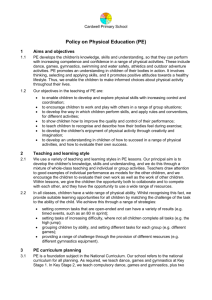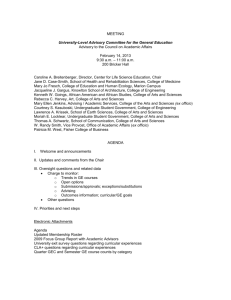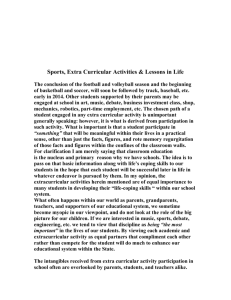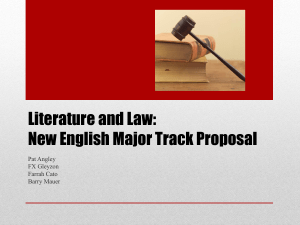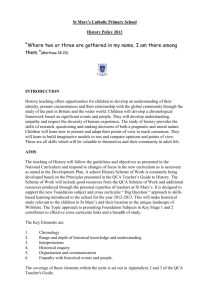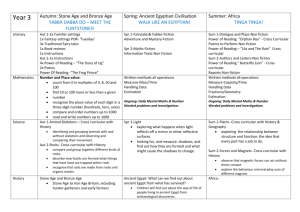TEMPLE COWLEY MIDDLE SCHOOL
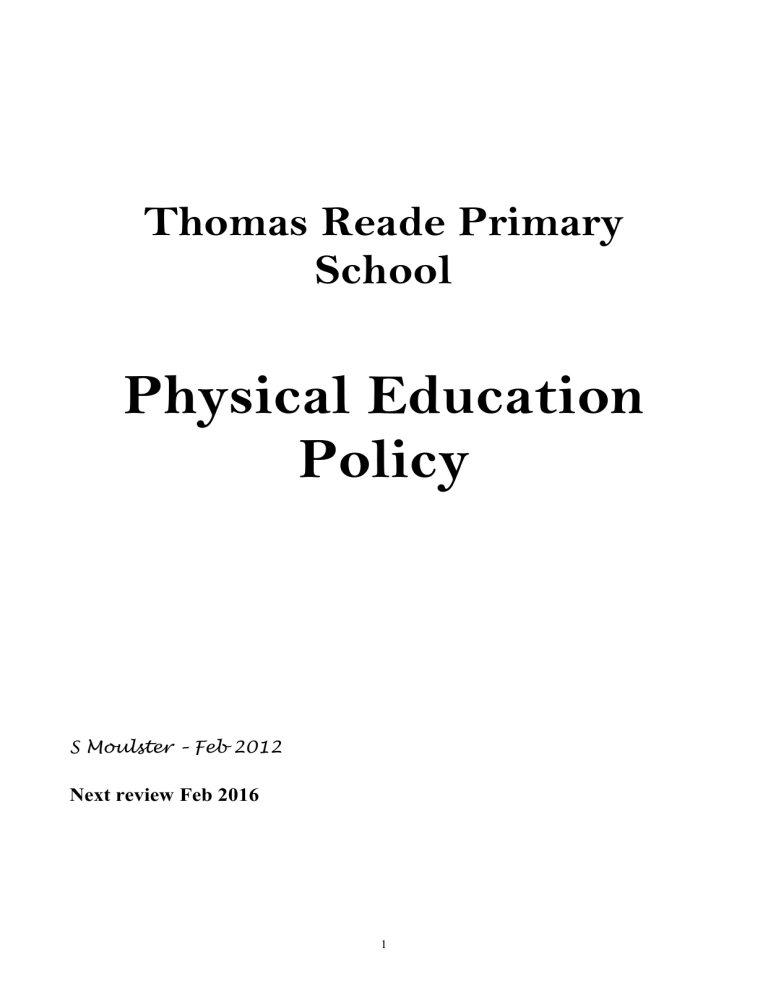
Thomas Reade Primary
School
Physical Education
Policy
S Moulster – Feb 2012
Next review Feb 2016
1
CONTENTS
Introduction
Aims and Objectives
Assessment, marking and recording
Classroom management, beginning and end of lessons
Communication within the department
Continuity and progression
Differentiation
Equal Opportunities
Discipline Plan
Lesson planner and record
Setting work for absence
Staff development and INSET
Health and Safety
Accidents
Special Educational Needs Policy
Cross Curricular Themes and I.C.T.
Extra Curricular Activities
Declaration of Sportspersonship
Curriculum and pupil organisation
Inventory
2
8
9
9
10
Page
3
4 - 6
7
10
11
12
12
12
13 - 14
14
15
16
17
18
19 – 21
22 - 23
The main purposes of this handbook are:-
•
To provide all staff in the School with information regarding the curriculum, organisation and management of P.E. in our school and a set of agreed policies.
• To identify a common set of goals for P.E. in our school.
•
To enable any new members of staff, interns, governors, interviewees, and other visitors to gain an insight into P.E. in our school.
1. INTRODUCTION
Physical Education at Thomas Reade Primary School has in the past been co-ordinated by the curriculum coordinator with support from staff and senior management. Staff have taught the
Physical Education programme to their own class. Swimming has been taught at Key stage 2 by external swimming instructors. The decision was made in September 2004 to appoint a specialist
Physical Education Teacher who would also take over the co-ordination of Physical Education with in the school.
Thomas Reade is one of 10 schools which make up the Abingdon Primary Schools partnership and we have wider connections with the Vale of White Horse Primary Schools and various
District Sports Associations. From September 2005 we will become part of a partnership of schools linked to King Alfred’s Sports Collage, Wantage; via our partnership secondary school,
John Mason. Over recent years Thomas Reade Primary School has enjoyed competing in a wide range of sporting activities at local, district, county level.
Physical Education at Thomas Reade Primary School is delivered as a foundation subject in the core of the National Curriculum. We adhere to the Central Council for Physical Recreation recommendation of a minimum of two hours of physical activity per pupil per week. Lessons are taught in mixed ability and mixed gender groups.
Staffing in the department consists of one part-time member, Mrs. S. Moulster, Curriculum Coordinator. We are also able to offer a full and flourishing range of extra-curricular activities which involves other members of staff from outside the P.E. department.
The indoor facilities we have to offer at Thomas Reade Primary School include a school hall and
The White Horse Leisure and Tennis Centre. Outside we benefit from a playing field, which accommodates during the autumn and spring terms, a soccer or hockey pitch, and a five a side pitch for practice and training. During the summer there is an athletics track, throwing and jumping areas; and rounders pitches. We also benefit from a hard-court area which can accommodate a netball court. Plans for 2005 include the marking out of four short tennis courts on the hard court area and grids for practice and training on the field.
AIMS AND OBJECTIVES FOR P.E.
3
This section will describe the aims and objectives for the teaching of P.E. that the department has endorsed.
The physical education curriculum is the learning and experience the subject provides for our children.. It facilitates the learning and development of the knowledge, concept, skills, qualities, values and attitudes reflected in the subject’s policy statement and curricular aims.
Physical education contributes to the development of a wide range of physical, social and personal skills and helps prepare all pupils for a healthy active lifestyle. It builds on children’s natural need for, and enjoyment of, activity and movement. Through the medium of physical education pupils can acquire and develop:
Skills motor social problem solving choreographic officiating observational recording organisational decision-making co-operation movement memory etc.
Knowledge rules anatomy/physiology sport history influence of culture health and fitness principles regulations first aid safety principles etc.
Concepts spatial tactical defence/attack continuity healthy lifestyle team work individual differences motif development speed patterns of play artistic expression etc.
Attitudes/values fair play honesty responsibility courage confidence tolerance self control positive active lifestyle co-operation etc.
Physical education focuses on the body and physical activity. Learning in both curricular and noncurricular time takes place through a planned variety of active movement experiences, it is this which distinguishes it from other areas of the curriculum and from play. Its unique contribution to the totality of education emerges from a sequential programme of physical activity, which is not necessarily confined to the years of compulsory schooling, or time spent in school. Physical education is about learning how , understanding why and knowing when to move.
The physical education National Curriculum order states:
“The programmes of study identify the aspects of physical education in which pupils make progress:acquiring and developing skills, selecting and applying skills, tactics and compositional ideas, evaluating and improving performance, knowledge and understanding of fitness and heath. These activities are developed through a range of activities at different key stages.”
(DFEE & QCA 1999)
The aims of physical education reflects the aims of the school, and reflects the processes of planning,
4
performing and evaluating as well as the strands permeating to the end of key stage descriptions relating to safety, health and exercise and the ability to work independently and with others.
Physical education should provide an enjoyable, satisfying, challenging and balanced programme which offers a range of experiences to meet the needs of individual children. The development of positive attitudes and the appreciation of each individual’s strengths and weaknesses should be considered essential elements of the learning process.
Breadth does not necessarily mean increasing the number of activities, but ensuring that curricular experiences are sufficiently wide and flexible to meet the needs of all children and support the full range of curricular aims.
“A school’s curriculum is judged by the extent to which its content, structure, organisation and implementation contribute to high standards in learning and give a true reflection of the school aims.” (The Handbook for the Inspection of Schools, OFSTED.
THE PHILOSOPHY OF THE P.E. DEPARTMENT
"Physical Education should provide the opportunity for all young people to become involved and to realise fully their potential." (Sports Council Young People in Sport 1992).
Work within the Physical Education department is designed to complement, support and foster the general aims of the school and to provide enjoyment and participation whilst at school and throughout life.
All children should receive a broad and balanced programme of P.E. which is differentiated to meet the needs of all children irrespective of their abilities, race, gender or culture. To help children achieve success in both co-operative and competitive physical activities.
Through variety in teaching styles opportunities are provided for children to work co-operatively and confidently as individuals and in group situations. The understanding of and the skills necessary to do this will be learnt through a developmental and progressive Physical Education Curriculum, encompassing key stages 1 and 2 of the National Curriculum, and the early learning goals of the curriculum at the foundation stage.
Movement appreciation and understanding of one's own and others strengths and weaknesses are developed through the provision of problem solving activities and experimental learning situations.
It is intended that children should be made aware of leisure opportunities within the community and are equipped with the necessary skills and attitudes to make full use of them.
5
OBJECTIVES
•
To develop and understand the importance of physical fitness and to be able to monitor it in order to stay fit and healthy for life.
• To develop self-esteem through the development of physical confidence.
• To develop co-operation communication and social skills.
•
To provide opportunities for the development of artistic and aesthetic movement and appreciation.
• To develop the ability to remember, adapt and apply knowledge, skills and concepts in a variety of movement - related activities.
• To develop an understanding of the basic strategies and terminology associated with individual, team, co-operative and competitive activities.
• To develop a knowledge of safety factors and an appreciation of the principles of safe practice.
• To provide an awareness of caring for equipment, facilities and each other.
6
ASSESSMENT AND MARKING POLICY.
This section will set out the policy on assessment of children’s progress.
RECORD KEEPING ASSESSMENT AND REPORTING
A register and teacher planner will monitor participation and progress.
Procedures for record keeping, assessment and reporting will be continuous and on going and will follow whole school policy. Children are given grades according to the school reporting system.
Assessment will be based on teacher observation, programmes of study and level descriptions which will be regularly used throughout the Key Stage. Levels/grades will be recorded at each half term for the areas of activity completed.
Assessment follows the four strands inherent in Physical Education.
1.
Acquiring and developing skills.
Consolidate their existing skills and gain new ones.
Perform actions and skills with more consistent control and quality.
2.
Selecting and applying skills, tactics and compositional ideas.
Plan, use and adapt strategies, tactics and compositional ideas for individual pair, small group and small-team activities.
Develop and use their knowledge of the principles behind the strategies, tactics and ideas to improve their effectiveness.
Apply rules and conventions for different activities.
3.
Evaluating and improving performance.
Identify what makes a performance effective.
Suggest improvements based on this information.
4.
Knowledge and understanding of fitness and health.
How exercise affects the body in the short term.
To warm up and prepare appropriately.
Why physical activity is good for their health and well-being.
Why wearing appropriate clothing and being hygienic is good for their health and safety.
7
CLASSROOM MANAGEMENT, STARTS AND ENDS OF LESSONS .
This section describes expectations of staff and children regarding lessons.
1.
Change into kit in Classroom/Cloakroom.
2.
Leave school uniform neatly on table/in cloakroom
P.E. Dress . White School T- shirt
Royal blue shorts
Royal blue socks (winter)
White socks (summer)
Training shoes
Football boots
Towel
A hat for protection from sun (summer)!
For both boys and girls a sweatshirt/tracksuit/extra pullover will be helpful for the cold weather.
3.
Children should remove all jewellery and tie back hair.
4.
Registration / Present and Participating
A Absent
N Note
NK No Kit
K Incorrect Kit
* Unexplained
5.
Collect equipment from outside store and walk to field or playground. Or proceed in a line to the hall for indoor lessons.
6.
Warm up.
7.
Complete lesson.
8.
Put equipment away.
9.
Return to classroom and get changed into school uniform.
10.
Return PE kit to cloakroom/ storage box.
8
COMMUNICATION WITHIN THE SCHOOL
This section should describe how effective communication will occur in the school.
The curriculum co-ordinator will communicate with other staff members via pigeon holes.
Information regarding sporting fixtures and clubs will be communicated to staff via notice boards in the staff room.
Dates for fixtures, inset, clubs, or special events will be noted in the school diary held in the school office.
Staff are not expected to leave lessons to take or make phone calls, in accordance with the school policy. The office staff take messages or ask callers to ring back.
COMMUNICATION WITH PARENTS/CARERS
The curriculum coordinator will ensure letters are sent out to parents regarding dates for fixtures, clubs and special events with reply slips where necessary.
The curriculum coordinator will ensure letters are sent out to parents regarding kit and changes to the Physical Education curriculum.
CONTINUITY AND PROGRESSION .
This section will describe how effective continuity and progression is achieved within the department.
• There is one part time P.E. specialist who teaches throughout the school and is able to monitor and achieve continuity and progression as a result.
• There is a structured curriculum planned over seven years across the foundation stage, Key Stages
1 and 2. Continuity and progression are achieved by revisiting and broadening areas of activity and units of work across the foundation stage and Key Stages 1 and 2. The first visit is an introduction to the unit encompassing low key skills and activities. The second visit is a basic course building on the previous skills. Subsequent visits are intermediate ones concentrating on more advanced movements, tactics and skills.
• Links with main secondary schools to establish progression at Key Stage 3.
• Extra-Curricular activities to promote and expand upon what is learnt in the classroom.
9
DIFFERENTIATION ACCORDING TO AGE, ABILITY, TASK & OUTCOME
This section will describe how the department ensures that a differentiated curriculum is provided.
• All activities are suitable for participation regardless of the competence of the participants.
• The department will use a range of appropriate strategies to differentiate work according to the various ability groupings.
• Common tasks which allow for different outcomes will be used. On occasions different tasks will be set within a class to enable each child to work at the appropriate level as described in the scheme of work.
• Children may work individually to improve personal skills.
• Children may also work in small groups (2's 3's 4's 5's) to improve their skills.
• Children may co-operate together.
• Children may compete 1 v 1
2 v 1
• Tasks may be teacher led.
2 v 2
• Tasks may be child centred.
• Tasks will vary according to the ability of the child or group.
3 v 1 etc.
EQUAL OPPORTUNITIES
We believe that Equal Opportunities is about ensuring that every member of the school community is regarded as being of equal worth and importance, irrespective of culture, race, religion, gender, sexual orientation, learning abilities, sensory or physical impairment, social class or lifestyle.
10
CLASS ROOM MANAGEMENT
This section will indicate the class room management.
The department will operate the school policy on behaviour and follow the classroom management plan, laid out below. The plan is communicated to the children at the beginning of the year and revisited where necessary.
Rules
1.
Have your correct P.E. Kit
2.
Change in 5 minutes, at the beginning and end of the lesson.
3.
Remove all jewellery and tie back hair.
4.
Follow instructions quickly.
5.
Do not leave the classroom or enter the Hall unless told to by a member of staff.
6.
Look after equipment and return it to the appropriate store.
Rewards
Individual
1.
Praise
2.
Merits
3.
Success letters
Class
1. Class points
2. Class Merits
3. Free Choice lesson or Free dress lesson.
Consequences
Self-Discipline is interwoven with the ethos of the subject. However, there are occasions when this breaks down.
1.
Verbal warning
2.
Time out. Leave the working area for five minutes.
3.
Sent outside the hall or back to the classroom and complete a behavioural response sheet.
Discuss behaviour at end of lesson.
4.
Warning letter followed by lunch time detention.
5.
Incident form/ Phone call home.
Severe Clause.
3 Kit marks = Warning letter followed by detention for repeated incident.
No Kit = Warning letter followed by detention for repeated incident.
Unsafe, inappropriate or violent behaviour = Immediate detention, incident form and withdrawal from the lesson.
Non-participation:
Children who are excused from P.E. for medical reasons may be asked to do written work or help assist with umpiring or refereeing.
Children who are not participating for any other reason may be given written work and a detention with a note of explanation.
Students not bringing kit will borrow kit from the school and take part in the lesson.
11
LESSON PLANNER AND RECORD OF LESSONS .
This section will state the policy on documentation re lesson planning and a record of lessons.
• All staff are expected to keep lesson plans and evaluations using appropriate planning sheets.
These will also be a record of lessons.
• The lesson records will enable work to be continued in the event of staff illness.
• If for any reason a lesson was cancelled or changed then this should be indicated on the evaluation sheet.
SETTING WORK FOR PLANNED ABSENCE .
This section sets out how work for supply staff should be set.
If staff know in advance that they are going to be absent i.e. on an INSET course then -
• They should leave appropriate work.
• Ensure pupils know that the work has to be done.
• Ensure that appropriate resources are available.
• Check that the work has been done and pupils performed according to Departmental expectation.
• Discuss the work in advance with the Curriculum Co-ordinator.
In the event of an unplanned absence then staff should try to send in appropriate work via the
Curriculum Co-ordinator or Head.
STAFF DEVELOPMENT AND INSET .
This section will describe how P.E. staff development will occur and how INSET opportunities may arise.
Individual courses/conferences:
• Each member of staff will have access to INSET and any INSET they attend should be added to their personal INSET record sheet, kept by the Inset Co-ordinator.
• Staff should discuss a course with the Curriculum Co-ordinator for P.E. and the Head before making an application.
12
HEALTH AND SAFETY POLICY
1) Staff should develop and use safe procedures within all areas of the P.E. Department.
2) Staff should be aware of potential hazards and act accordingly.
3) Staff should ensure that risks to health and safety are minimised by vigilance particularly in respect to apparatus and equipment used.
4) Staff should teach safe practice and awareness of obvious, presumed and anticipated hazards.
5) Staff should ensure that adequate risk assessment has been made before commencing activities.
6) Staff should encourage children’s awareness and understanding of safety procedures.
7) Staff working in the P.E. department should comply with the school safety policy and take account National recommendations and guidelines.
8) Staff teaching swimming should hold a current ASA teaching certificate.
9) Staff working in the P.E. department should hold a current emergency first aid certificate.
10) Staff working in the P.E. department using the trampoline must be qualified.
11) Electrical equipment used by the department, i.e. CD Players are checked annually by M.
Philpott.
12) Fire and First Aid Information - Regulations are prominently displayed with in the school.
13) The curriculum coordinator promises to buy only equipment of high safety quality following
British and European Standards, e.g. carrying the KITE mark of the BSI and BEAB.
14) The curriculum coordinator is willing to co-operate in consultation and inspection in Health and
Safety matters.
15) Staff members are aware that one should raise matters of Health and Safety with J. Serle.
Curriculum Co-ordinator for the Physical Education Department should:a) Inform staff of relevant Health and Safety regulations. b) Ensure all staff are properly trained in activities undertaken. c) Act upon information received from staff and children regarding faulty equipment. d) Ensure that regular checks of all apparatus and equipment are carried out and maintained to prescribed standards. e) Allocate recourses when necessary on matters of Health and Safety.
Staff working within the Physical Education Department should:a) Work within the departmental policy and follow safe working practices. b) Take all reasonable care of the children in their charge. c) Carry out regular safety checks on fixed equipment in the Gymnasium/on the courts and playing field. Also check, regularly the safety of portable equipment. d) Inform other staff and the Curriculum Co-ordinator for Physical Education of known potential hazards and take appropriate action. Same procedures apply if children report faulty equipment as hazards. e) Investigate accidents and dangerous occurrences as well as near misses to help prevent reoccurrences and report them to the Curriculum Co-ordinator, f) Comply with the school Health and Safety Policy, the Physical Education Department Policy and be familiar with guidance on good Health and Safety practice recommended in -
B.A.A.L.P.E: Safe Practice in Physical Education.
DfES: Safety in Outdoor Education.
Out and about with Oxfordshire.
13
General Procedures: a) Staff should ensure that they comply with any specific regulations related to particular activities. b) All staff and children should wear appropriate clothing and footwear and remove jewellery before participating in any physical activity. c) No children should use apparatus on equipment unless under direct supervision. d) All accidents to staff and children must be reported and appropriate action taken including the completion of an accident report form.
Equipment: a) Equipment and apparatus which is purchased should conform to British Standards on European
Standards and be maintained to that standard. b) All equipment should be stored safely and appropriately. c) Any equipment or apparatus which is unsafe must be removed from use. Arrangements need to be made to dispose of condemned items. d) A first aid box with appropriate contents should be available. e) Trampoline: 1) locked in the hall when not in use.
2) only used by trained staff, who attend four yearly refresher
courses and observe county safety standards. f) Gymnastic Equipment used by qualified P.E. Specialists only. g) Guidance is given to students when they are required to handle and carry equipment. h) Throwing implements: Strict guidelines are given to the children regarding the carrying of equipment when, where and how to throw the implements by specialist P.E. staff.
ACCIDENTS
This section will describe the procedure to follow in the event of an accident during P.E.
• An accident or incident occurring in a P.E. lesson will be dealt with and treated as necessary by the member of staff.
• Incident and treatment to be recorded in First Aid incident book – kept in the school office.
• Where treatment is given, a letter is sent home with child explaining treatment given. (copy of letter enclosed)
• For major injuries emergency first aid given and medical help sent for - follow recording procedures as outlined by OCC documents. (enclosed)
• P.E. Staff are current holders of an emergency First Aid Certificate.
14
SPECIAL EDUCATIONAL NEEDS POLICY
Children with special educational needs in P.E. will fall into one of the following categories:
• Sensory difficulties
• Physical difficulties
• Cognitive limitations
• Emotional and behavioural disorders
Staff should be aware of these problems and deal with each case as the need arises.
Children with SEN will require extra consideration if they are to be successfully involved in Physical
Education.
With appropriate planning and delivery it is possible for all children to participate, achieve success and develop skills, knowledge and understanding.
Any modifications or adaptation the teacher may be required to make should be undertaken with the principle of entitlement, accessibility, integration and integrity in mind.
Staff should report any children with special needs to the curriculum co-ordinator for special needs to help develop appropriate strategies to deal with each individual case.
Children who are unable to swim 25 meters by the end of Key Stage 2 will if possible be given extra swimming lessons to try to help them achieve this National Curriculum requirement.
Children who are SEN should be monitored and evaluated at staff meetings.
There is also the facility for support staff to aid children who are SEN in Physical Education. This is provided by Teaching Assistants.
15
CROSS CURRICULAR THEMES AND ICT
Schemes of work have been written to include cross curricular aspects when appropriate. The main
Cross Curricular matters in Physical Education are:
• Health Education: - Health Related Exercise
- Safety Aspects
• Education for Citizenship:
- Personal and Social
- Working with others
- Equal Opportunities
• Environmental Education:
- Outdoor Environments
- Indoor Environments
- Environments Outside School
- Care of the Environment
• Careers' Education and Guidance:- Leisure Opportunities
- Physical Education Opportunities
• Economic and Industrial understanding: - Cost and Care of Equipment and Facilities
Common Cross Curricular Skills Involved in Physical Education are:-
- Communication
- Numeracy
- Literacy.
- Problem Solving
- Personal and Social
- Information and Communication Technology
Information and Communication Technology
Photographs and Video recording of work is used on occasions in order that the children can carry out a self evaluation of their performance.
Monitoring and assessment results are kept on spreadsheets in order to facilitate reporting to parents and to class teachers.
Results in athletics are to be put on a data base/spreadsheet in order to allow analysis of results.
Staff have access to the ICT suite, a laptop, a digital camera and a video camera.
16
EXTRA CURRICULAR ACTIVITIES
Extra curricular activities are organised within the department to supplement and enhance the
Physical Education curriculum. Activities are run by the specialist P.E. staff aided by other members of the teaching staff in order that a wide range of interests can be provided for. The department aims to provide a wide range of activities in order to appeal to all year groups and both genders.
Thomas Reade Primary school partakes in a wide range of tournaments, fixtures and festivals within the town, district, county and further afield. We benefit from links with the Vale of White Horse
Sports Development Team who aid in the organisation of local events, and from links with various sports clubs.
Staff involved in extra curricular activities should take note of the following points, and ensure that pupils are aware of those applicable to them.
All after school activities run from 3:05 until approximately 4:15 unless notified otherwise by the member of staff involved.
Children should ensure they inform their parents or carers by taking home a letter if they intend to stay behind for an activity.
Staff will endeavour to inform children in advance if activities are cancelled or postponed for any reason.
Children will be expected to inform the member of staff involved if they are unable to attend a training session or club.
Where children are selected to represent the school they are expected to sign and follow the declaration of sportspersonship, and the School Behavioural code
The Extra Curricular activity programme includes the following:
Year 5, 6, Soccer Teams are entered into Vale League and Cups.
Year 3, 4, 5 and 6 Netball Club.
Year 5 and 6 Hockey Club.
Year 5, and 6 Athletics Team.
Year 5 and 6 Kwik Cricket Team, Vale and County Competitions.
Extra Curricular activities planned for 2005/06
Gymnastic Club.
Trampoline Club.
Tag-Rugby Team.
Netball Club.
Football Club.
Inter-House Competitions
Initially inter-house athletics (Sports Day) Summer 2005
Others will be introduced in 2005/06.
17
THOMAS READE PRIMARY SCHOOL
DECLARATION OF SPORTSPERSONSHIP
I will always follow the Thomas Reade Primary School Code of Behaviour.
I understand that participating in Sports Clubs or Teams, is a privilege and that if I do not follow the
Thomas Reade Primary School Code of Behaviour, I will lose that privilege.
I will always act in a fair and sporting manner, when taking part in sports activities in and out of school.
I will inform my parents/carers of times, dates and venues of club events and fixtures, well in advance, by taking home any letters/information given to me.
I will return any reply slips to the member of staff in charge by the date/time specified.
I will inform the member of staff in charge, if I am unable to attend for any reason.
I will arrive at the club, event or fixture, on time, with all the appropriate kit or equipment.
I will ask permission of members of staff well in advance, if I wish to be excused lessons and ensure that any set classwork/homework is done.
I will be polite and courteous to all Members of Staff and Adult helpers and to my fellow team- mates or club Members.
I will look after any equipment used and assist in carrying and setting up of equipment at the beginning and end of a session.
I will always act as a sporting ambassador for Thomas Reade Primary School in the outside community.
I have read and support the Declaration of Sportspersonship as set out above.
Signature of child.........................................................................................................
Date............................
Signature of Parent/Guardian....................................................................................
18
CURRICULUM ORGANISATION AND PUPIL GROUPINGS .
This section will set out curriculum information, and syllabuses.
PHYSICAL EDUCATION CURRICULUM STATEMENT
FOUNDATION STAGE
Children have the opportunity to move and play, alone and with others, in both indoor and outdoor environments. They will experience the curriculum through a range of planned, structured play situations. They will have an opportunity to find out and learn about their world and to develop a range of skills that promote their own physical development. They will follow the early learning goals for physical development.
KEY STAGE 1 (Years 1 and 2)
The Key stage 1 classes will have experienced Foundation Stage Early learning goals in Physical
Development. The emphasis will be to build upon their natural enthusiasm for movement using it to explore and learn about their world. By watching listening and experimenting with movement ideas, they develop their skills in movement and their coordination, and enjoy expressing and testing themselves in a variety of situations.
Children will pursue programmes of study in five areas of activity. Games units 1 and 2,
Gymnastic Activities units 1and 2, Dance units 1 and 2, Athletic Activities unit 1, and Outdoor and Adventurous Activities unit 1.
KEY STAGE 2 ( Years 3, 4, 5 & 6)
The Key stage 2 classes will have experienced Key Stage 1. The emphasis will be to build upon the confidence and competence of basic movement skills, knowledge and understanding already established and also to enhance positive attitudes towards physical activity. The aim is to build on the foundation of movement literacy and continue to promote participation in physical activity.
Work during this key stage will enable children to reach the requirements of the end of key stage statements by:-
-
Extending and refining children’s motor skills and co-ordination.
- Providing opportunities for children’ spontaneous and inventive qualities to develop.
- Providing opportunities for practice, repetition and initiation to consolidate and enhance personal skills.
-
Extending children’s ability to tackle new and more complex tasks.
- Increasing the opportunities for co-operation and competition.
- Expanding pupils' problem solving and evaluation skills.
- Sustaining energetic activity over a longer period of time and understand the effects on the body.
19
Children will pursue programmes of study in six areas of activity. Games (Invasion games units
1- 4, Striking and fielding games units 1 and 2, Net/Wall games units 1 and 2) Gymnastic
Activities units 3-6, Dance units 3-6, Swimming units 1 and 2, Athletic Activities units 2 and 3 and Outdoor and Adventurous Activities units 2 and 3.
KEY STAGE 1 – BASED OF TIME ALLOCATION
Approximate time allocations assuming a 39 week year. 2 hours per week
Term 1and 2 (14 weeks)
Term 3 and 4 (12 weeks)
Term 5 and 6 (13 weeks)
Year
1
Year
2
Games 7
Gymnastics 7
Dance 14
Games 7
Gymnastics 7
Dance 14
Gymnastics 12
Games 6
OAA 6
Gymnastics 12
Games 6
OAA 6
Athletics 7
Games 13
Dance 6
Athletics 7
Games 13
Dance 6
KEY STAGE 2 - BASED ON TIME ALLOCATION
Approximate time allocations assuming a 39 week year.
Year
3 and 4
Year
5 and 6
Term 1(14 weeks)
Gymnastics 14
Games 14
Gymnastics 7
Games 7
Swimming 10
Dance 4
Term 2 (12 Weeks)
Swimming 10
Dance 5
OAA 5
Games 4
Gymnastics 6
Games 10
Dance 2
OAA 6
Term 3 (13 Weeks)
Games 14
Athletics 7
Swimming 5
Games 14
Athletics 7
Swimming 5
20
PHYSICAL EDUCATION - SCHEMES OF WORK
KEY STAGE 2
B
Supporting
Body Weight
(Balance)
C
Change of
Shape,
Speed direction
(Sequence work)
D
Travelling
(turning, swinging climbing, flight)
E
Floor and
Apparatus
(sequence work)
GYMNASTIC
ACTIVITIES
A
Travelling
(Rolling,
Jumping
Travel on hands and feet)
DANCE
A
The Body
B
Actions
C
Space
D
Dynamics
(Rhythm)
E
Relationships
& Stimuli
GAMES
A
Developme nt of
Games
Skills by an introduction to:
B
Net Games
Short
Tennis
C
Invasion
Games
Soccer,
Basketball
New Image
Rugby
D
Striking
Games
Kwik
Cricket
Rounders.
E
Sportsmanship
ATHLETIC
ACTIVITIES
A
Running
Short
Distances
B
Running -
Long
Distances
C
Jumping
D
Throwing
E
Competitions
OUTDOOR &
ADVENTUROUS
ACTIVITIES
A
Experiencing
Different
Environments
B
Safety
C
Orienteering
D
Country Code
Extra Curricular
Activities
Programme
SWIMMING
A
Swim
unaided, at least 25m.
B
Stroke
Development
C
Confidence
D
Water Safety
& Survival skills
E
Simple
Games
21
INVENTORY
ATHLETICS
Indoor throwing implements.
Foam Javelins 6
Foam Shot
Foam Discus 16
Small hurdles
Relay batons
Measuring and Marking
Measuring tapes (50m) 2
(30m) 4
(20m) 3
(10m) 3
Miscellaneous
Stop watches 6
Starting pistols
Starting Clapper 2
Relay Batons 10
DANCE
CD and tape player
Various tapes and videos
GAMES
Basketball.
Balls
Ball bags
20
2
Cricket
Wind balls in basket
Cricket balls
Cricket pads.
Bats
Wicket Keeper Glove sets
Sets of spring stumps
Boundary markers
Cricket (Match Bag)
Bag 1
Bats 5
Sets of pads 5
Stumps with bails 6
Sets of batting gloves 5
(3RH 2LH)
Pair of wicket keeping gloves 1
22
Hockey
Sticks 25
Sticks (Team set) 12
Sticks (Unihock) 14
Balls 6
Goal keeping protection 1 set
Rounders
Bats
Balls
Posts
Bases
Tag Rugby
Balls
Ball bags
Tags
10
1
20
2
4 sets
Short Tennis
Rackets 15
Low compression balls 30
Tennis
Rackets (Slazengers cadet with covers) 10
Rackets (Dunlop junior with covers) 12
Rackets (Dunlop mini with covers)
Balls
Sets of Posts 4
Nets 4
Soccer
Balls
Ball bags
Bibs
Corner flags
Goal nets
35
3
2 sets
4
2
Softball
Set of bases
Home plate
Pitching plate
RH Mitts
LH Mitts
Bats
Balls
Volley Ball
Soft touch Volleyballs 15
GYMNASTICS and TRAMPOLINING
Mats
Safety mats
Horse
Ladder box
12
1
Layered 5 piece box
Movement tables 2
Movement boxes 6
Planks 4
Benches 4
Low parallel bars 2
Trampette
Spring boards
Benches 4
Horizontal Bars 2
Cage (wall bars) 1
OUTDOOR AND ADVENTUROUS
ACTIVITIES
Orienteering
Plastic control markers 10
Maps (with numbers) 30
MISCELLANEOUS
Electric Compressor 1
Megaphone
Assorted hoops
Various skipping ropes
Marker cones 3 Sets
Numbered Bibs 4 Sets
23
